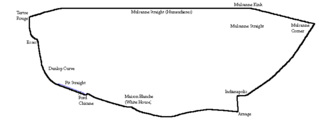Long tail is a consumer demographic in business.
Contents
Long tail or longtail may also refer to:
Long tail is a consumer demographic in business.
Long tail or longtail may also refer to:

In probability theory and statistics, a probability distribution is the mathematical function that gives the probabilities of occurrence of different possible outcomes for an experiment. It is a mathematical description of a random phenomenon in terms of its sample space and the probabilities of events.

The Pareto distribution, named after the Italian civil engineer, economist, and sociologist Vilfredo Pareto, is a power-law probability distribution that is used in description of social, quality control, scientific, geophysical, actuarial, and many other types of observable phenomena; the principle originally applied to describing the distribution of wealth in a society, fitting the trend that a large portion of wealth is held by a small fraction of the population. The Pareto principle or "80-20 rule" stating that 80% of outcomes are due to 20% of causes was named in honour of Pareto, but the concepts are distinct, and only Pareto distributions with shape value of log45 ≈ 1.16 precisely reflect it. Empirical observation has shown that this 80-20 distribution fits a wide range of cases, including natural phenomena and human activities.
A tail is the section at the rear end of an animal's body, a distinct, flexible appendage to the torso.

The macaques constitute a genus (Macaca) of gregarious Old World monkeys of the subfamily Cercopithecinae. The 23 species of macaques inhabit ranges throughout Asia, North Africa, and Europe. Macaques are principally frugivorous, although their diet also includes seeds, leaves, flowers, and tree bark. Some species such as the long-tailed macaque will supplement their diets with small amounts of meat from shellfish, insects, and small mammals. On average, a southern pig-tailed macaque in Malaysia eats about 70 large rats each year. All macaque social groups are arranged around dominant matriarchs.

The crab-eating macaque, also known as the long-tailed macaque and referred to as the cynomolgus monkey in laboratories, is a cercopithecine primate native to Southeast Asia. A species of macaque, the crab-eating macaque has a long history alongside humans. The species has been variously seen as an agricultural pest, a sacred animal, and, more recently, the subject of medical experiments.

There have been many human powered vehicles designed and constructed specifically for transporting loads since their earliest appearance in the 20th century. They are referred to variously depending on the number of wheels — typically two, three, or four — and by their specific use. Adjectives used to describe the tasks to which the bicycles, dicycles, tricycles, or quadracycles are put include cargo cycles, freight cycles, box cycles, carrier cycles, and so on. Sometimes they are also called cycletrucks, which uses a sense of the word 'truck' predating the automobile.

The lion-tailed macaque, also known as the wanderoo, is an Old World monkey endemic to the Western Ghats of South India.

In statistics and business, a long tail of some distributions of numbers is the portion of the distribution having many occurrences far from the "head" or central part of the distribution. The distribution could involve popularities, random numbers of occurrences of events with various probabilities, etc. The term is often used loosely, with no definition or an arbitrary definition, but precise definitions are possible.
A long-tailed or heavy-tailed distribution is one that assigns relatively high probabilities to regions far from the mean or median. A more formal mathematical definition is given below. In the context of teletraffic engineering a number of quantities of interest have been shown to have a long-tailed distribution. For example, if we consider the sizes of files transferred from a web server, then, to a good degree of accuracy, the distribution is heavy-tailed, that is, there are a large number of small files transferred but, crucially, the number of very large files transferred remains a major component of the volume downloaded.

The stump-tailed macaque, also called the bear macaque, is a species of macaque native to South Asia and Southeast Asia. In India, it occurs south of the Brahmaputra River, in the northeastern part of the country. Its range in India extends from Assam and Meghalaya to eastern Arunachal Pradesh, Nagaland, Manipur, Mizoram and Tripura.

The 1970 24 Hours of Le Mans was the 38th Grand Prix of Endurance and took place on 13 and 14 June 1970. It was the 8th stage of the 1970 World Sportscar Championship season.

Xtracycle is the name of a company and the name commonly used for the variety of load-carrying bicycle, a longtail or a longbike, that results from use of the company's products: the FreeRadical kit, complete long-frame bicycles and associated accessories. Web forums and blogs often use the shorthand Xtrabike, Xtra, or simply X to refer to either the FreeRadical extension or the entire extended bicycle. An Xtracycle may be constructed by modifying an existing bicycle with a Free Radical extension, or by custom-building an extended-tail bicycle frame.

The black swan theory or theory of black swan events is a metaphor that describes an event that comes as a surprise, has a major effect, and is often inappropriately rationalized after the fact with the benefit of hindsight. The term is based on an ancient Roman saying expressing the European presumption that black swans did not exist until Dutch mariners saw them in Australia in 1697, and the term was then reinterpreted to mean an unforeseen and consequential event.
In probability theory, heavy-tailed distributions are probability distributions whose tails are not exponentially bounded: that is, they have heavier tails than the exponential distribution. In many applications it is the right tail of the distribution that is of interest, but a distribution may have a heavy left tail, or both tails may be heavy.

In statistics, the concept of the shape of a probability distribution arises in questions of finding an appropriate distribution to use to model the statistical properties of a population, given a sample from that population. The shape of a distribution may be considered either descriptively, using terms such as "J-shaped", or numerically, using quantitative measures such as skewness and kurtosis.
Self-similar processes are types of stochastic processes that exhibit the phenomenon of self-similarity. A self-similar phenomenon behaves the same when viewed at different degrees of magnification, or different scales on a dimension. Self-similar processes can sometimes be described using heavy-tailed distributions, also known as long-tailed distributions. Examples of such processes include traffic processes, such as packet inter-arrival times and burst lengths. Self-similar processes can exhibit long-range dependency.

The northern pig-tailed macaque is a vulnerable species of macaque in the subfamily Cercopithecidae. It is found in Bangladesh, Cambodia, China, India, Laos, Myanmar, Thailand, and Vietnam. Traditionally, M. leonina was considered a subspecies of the southern pig-tailed macaque, but is now classified as an individual species. In the 21st century, the pig-tailed macaque was split into the northern pig-tailed macaque species Macaca leonina and the Sundaland pig-tailed macaque species M. nemestrina. This reclassification was aided by the observation of sexual swellings and basic attributes that distinguish the two. The northern pig-tailed macaque is frugivorous and their social grouping is matriarchal, where sexual dimorphic traits can distinguish males and females. Their adaptation to omnivorous diets occur in periods of fruit scarcity, munching on wild vegetation and crops, human foods, and small insects and mammals. Despite their adaptability, northern-pig tailed macaques experience viral threats such as the human immunodeficiency virus type 1, pathogenic simian immunodeficiency, and coronavirus. Human impacts are also present, such as agricultural expansions, aquaculture, transportation infrastructure, hunting and logging for meat and trophies, and the illegal pet trade; that result in habitat loss, forest fragmentation, and a reduced well-being.
Several fish species are known as northern bluefin tuna, including: